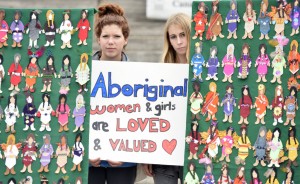
The Native Women’s Association of Canada rallied on Parliament Hill on October 4, 2013. Photo credit: iPolitics/Matthew Usherwood
Aboriginal advocacy groups are feeling disappointment after a long-awaited government report failed to meet expectations. The report, titled “Invisible Women: A Call To Action,” was designed to address an alarming issue that has been plaguing aboriginal communities for years—that women and girls are murdered or go missing at an unusually high rate.
According to Amnesty International Canada, aboriginal women are five to seven times more likely to die as a result of violence than non-aboriginal women. And according to the Native Women’s Association of Canada (NWAC), two to three aboriginal women or girls are reported missing or murdered each month in Canada. Independent researcher Maryanne Pearce says that the number of aboriginal women who have been murdered or gone missing is much higher than previously thought, having herself recently compiled a database of more than 800 cases.
But numbers can only tell so much—they can’t convey the devastation and heartbreak felt by the families, friends, and communities in which these women lived. For that there are countless stories. The most recent and public of these is that of Loretta Saunders, a 26-year-old Inuk woman who disappeared on February 13th and was found murdered two weeks later. In a case of tragic irony, Saunders, a student of Saint Mary’s University, had in fact been passionately doing her thesis on the phenomenon of missing and murdered aboriginal women.
Advocacy groups have been fighting to bring attention to this issue for quite some time. The most recent effort took place this past October, when the NWAC organized a rally on Parliament Hill. The main hope has been that the government would set in motion a national public inquiry. However, the report produced on March 7th, tabled in parliament by the Special Committee on Violence Against Indigenous Women, did not do as such. It put forth 16 recommendations for action, but many feel that these are nothing new.
In response to these criticisms, government officials, such as Justice Minister Peter MacKay, have pointed to the many anti-crime initiatives and studies on violence against aboriginal women that have taken place over the years.
The murder and disappearance of aboriginal women is no doubt interconnected with many other issues experienced by aboriginal communities as a whole. Any kind of investigation into its causes, therefore, must take into account the social, political, and historical contexts in which aboriginal women live. If you’re interested in doing some research, UTP Journals has a number of scholarly articles pertaining to aboriginal issues you can check out:
Aboriginal Income Disparity in Canada, from Canadian Public Policy 37.1;
The Neighbourhood Context of Urban Aboriginal Crime, from Canadian Journal of Criminology and Criminal Justice 50.5;
Ontological Destruction: Genocide and Canadian Aboriginal Peoples, from Genocide Studies and Prevention 4.1;
Constructed and Contested Truths: Aboriginal Suicide, Law, and Colonialism in the Canadian West(s), 1823-1927, from Canadian Historical Review 86.4; and
Aboriginal People and Confidence in the Police, from Canadian Public Policy Advanced Online.
How do you feel about the Canadian government’s response to missing and murdered aboriginal women? What measures can be done to alleviate this problem and restore justice to those that have been lost? Tweet us your thougts @utpjournals.
Comments on this entry are closed.